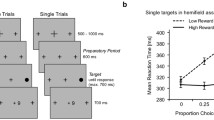Abstract
The current study investigated the effect of conscious intention to act on the Bereitschaftspotential. Situations in which the awareness of acting is minimally expressed were generated by asking 16 participants to press a button after performing a mental imagery task based on animal pictures (automatic condition). The affective responses induced by the pictures were controlled by selecting the animals according to different valences, threatening and neutral. The Bereitschaftspotential associated with the button presses was compared to the observed when similar movements were performed under the basic instructions of the self-paced movement paradigm (willed condition). Enhanced Bereitschaftspotential amplitudes were observed in the willed condition with respect to the automatic condition. This effect was manifested as a negative slope at medial frontocentral sites during the last 500 ms before movement onset. The valence of the pictures did not affect the motor preparatory potentials. The results suggest that significant part of the NS’ subcomponent of the readiness potential is associated with the attention to—and, presumably, awareness of—intention to move, possibly reflecting cortical activation from supplementary motor areas. Secondarily, our findings supports that the feeling of threat does not influence the Bereitschaftspotential associated with automatic movements. Regarding methodological issues, the behavioural model of spontaneous voluntary movements proposed in automatic condition can benefit investigations on purely motor (or non-cognitive) subcomponents of the Bereitschaftspotential.



Similar content being viewed by others
References
Aron AR, Poldrack RA (2006) Cortical and subcortical contributions to stop signal response inhibition: role of the subthalamic nucleus. J Neurosci 26(9):2424–2433
Baars BJ (2005) Global workspace theory of consciousness: Toward a cognitive neuroscience of human experience. Progr Brain Res 150:45–53
Baker KS, Mattingley JB, Chambers CD, Cunnington R (2011) Attention and the readiness for action. Neuropsychologia 49(12):3303–3313
Bortoletto M, Lemonis MJ, Cunnington R (2011) The role of arousal in the preparation for voluntary movement. Biol Psychol 87(3):372–378
Bosch V, Mecklinger A, Friederici AD (2001) Slow cortical potentials during retention of object, spatial, and verbal information. Cogn Brain Res 10(3):219–237
Brainard DH (1997) The psychophysics toolbox. Spatial Vis 10:433–436
Brass M, Haggard P (2007) To do or not to do: the neural signature of self-control. J Neurosci 27(34):9141–9145
Curtis CE, Cole MW, Rao VY, D’Esposito M (2005) Canceling planned action: an fMRI study of countermanding saccades. Cereb Cortex 15(9):1281–1289
Dehaene S, Naccache L (2001) Towards a cognitive neuroscience of consciousness: basic evidence and a workspace framework. Cognition 79(1–2):1–37
Delorme A, Makeig S (2004) EEGLAB: an open sorce toolbox for analysis of single-trail EEG dynamics including independent component anlaysis. J Neurosci Methods 134(1):9–21
Dirnberger G, Duregger C, Lindinger G, Lang W (2004) Habituation in a simple repetitive motor task: a study with movement-related cortical potentials. Clin Neurophysiol 115(2):378–384
Farah MJ, Weisberg LL, Monheit M, Peronnet F (1989) Brain activity underlying mental imagery: event-related potentials during mental image generation. J Cogn Neurosci 1(4):302–316
Frith CD, Friston K, Liddle PF, Frackowiak RSJ (1991) Willed action and the prefrontal cortex in man: a study with PET. Proc R Soc London B Biol Sci 244(1311):241–246
Grecucci A, Balaban E, Buiatti T, Budai R, Rumiati RI (2009) The emotional control of action: ERP evidence. Arch Ital Biol 147(1–2):37–49
Haggard P, Eimer M (1999) On the relation between brain potentials and the awareness of voluntary movements. Exp Brain Res 126(1):128–133
Ikeda A, Lüders HO, Burgess RC, Shibasaki H (1992) Movement-related potentials recorded from supplementary motor area and primary motor area. Brain 115(4):1017–1043
Isoda M, Hikosaka O (2011) Cortico-basal ganglia mechanisms for overcoming innate, habitual and motivational behaviors. Eur J Neurosci 33(11):2058–2069
Jankelowitz S, Colebatch J (2002) Movement-related potentials associated with self-paced, cued and imagined arm movements. Exp Brain Res 147(1):98–107
Jung TP, Humphries C, Lee TW, Makeig S, McKeown MJ, Iragui V, Sejnowski TJ (1998) Extended ICA removes artifacts from electroencephalographic recordings. In: Advances in Neural Information Processing Systems, pp 894–900
Keller I, Heckhausen H (1990) Readiness potentials preceding spontaneous motor acts: voluntary vs. involuntary control. Electroencephalogr Clin Neurophysiol 76(4):351–361
Kitamura J, Shibasaki H, Takagi A, Nabeshima H, Yamaguchi A (1993) Enhanced negative slope of cortical potentials before sequential as compared with simultaneous extensions of two fingers. Electroencephalogr Clin Neurophysiol 86:176–182
Kornhuber HH, Deecke L (1965) Hirnpotentialänderungen bei Willkürbewegungen und passiven Bewegungen des Menschen: Bereitschaftspotential und reafferente Potentiale. Pflüger’s Archiv für die Gesamte Physiol des Menschen der Tiere 284(1):1–17
Kutas M, Donchin E (1974) Studies of squeezing: handedness, responding hand, response force, and asymmetry of readiness potential. Science 186(4163):545–548
Lau HC, Rogers RD, Ramnani N, Passingham RE (2004) Willed action and attention to the selection of action. Neuroimage 21(4):1407–1415
Libet B, Gleason CA, Wright EW, Pearl DK (1983) Time of conscious intention to act in relation to onset of cerebral activity (readiness-potential). The unconscious initiation of a freely voluntary act. Brain 106(3):623–642
Masaki H, Takasawa N, Yamazaki K (1998) Enhanced negative slope of the readiness potential preceding a target force production task. Electroencephalogr Clin Neurophysiol 108(4):390–397
McAdam DW, Seales DM (1969) Bereitschaftspontential enhancement with increased level of motivation. Electroencephalogr Clin Neurophysiol 27(1):73–75
Metz GA (2007) Stress as a modulator of motor system function and pathology. Rev Neurosci 18(3–4):209–222
Metz GA, Jadavji NM, Smith LK (2005) Modulation of motor function by stress: a novel concept of the effects of stress and corticosterone on behavior. Eur J Neurosci 22(5):1190–1200
Navarro M, Miyamoto N, van der Kamp J, Morya E, Ranvaud R, Savelsbergh GJP (2012) The effects of high pressure on the point of no return in simulated penalty kicks. J Sport Exerc Psychol 34(1):83–101
Norman DA, Shallice T (1986) Attention to action: willed and automatic control of behavior. In: Davidson RJ, Schwartz GE, Shapiro D (eds) Consciousness and self-regulation: advances in research and theory, Springer, New York, Plenum, pp 1–18
Oda S, Shibata M, Moritani T (1996) Force-dependent changes in movement-related cortical potentials. J Electromyogr Kinesiol 6(4):247–252
Pashler H (1994) Dual-task interference in simple tasks: data and theory. Psychol Bull 116(2):220–244
Perri RL, Berchicci M, Lucci G, Cimmino RL, Bello A, Di Russo F (2014) Getting ready for an emotion: specific premotor brain activities for self-administered emotional pictures. Front Behav Neurosci 8:197
Perrin F, Pernier J, Bertrand O, Echallier JF (1989) Spherical splines for scalp potential and current density mapping. Electroencephalogr Clin Neurophysiol 72(2):184–187
Rektor I, Fève A, Buser P, Bathien N, Lamarche M (1994) Intracerebral recording of movement related readiness potentials: an exploration in epileptic patients. Electroencephalogr Clin Neurophysiol 90(4):273–283
Rektor I, Bareš M, Kaňovský P, Kukleta M (2001) Intracerebral recording of readiness potential induced by a complex motor task. Mov Disord 16(4):698–704
Schultze-Kraft M, Birman D, Rusconi M, Allefeld C, Görgen K, Dähne S, Blankertz B, Haynes JD (2016) The point of no return in vetoing self-initiated movements. Proc Natl Acad Sci 113(4):1080–1085
Shibasaki H, Barrett G, Halliday E, Halliday AM (1980) Components of the movement-related cortical potential and their scalp topography. Electroencephalogr Clin Neurophysiol 49(3–4):213–226
Shibasaki H, Sadato N, Lyshkow H, Yonekura Y, Honda M, Nagamine T, Suwazono S, Magata Y, Ikeda A, Miyazaki M, Fukuyama H, Asato R, Konishi J (1993) Both primary motor cortex and supplementary motor area play an important role in complex finger movement. Brain 116(6):1387–1398
Simonetta M, Clanet M, Rascol O (1991) Bereitschaftspotential in a simple movement or in a motor sequence starting with the same simple movement. Electroencephalogr Clin Neurophysiol 81:129–134
Tononi G, Edelman GM (1998) Consciousness and complexity. Science 282:1846–1851
Van Gemmert AWA, Van Galen GP (1997) Stress, neuromotor noise, and human performance: a theoretical perspective. J Exp Psychol Hum Percept Perform 23(5):1299–1313
Walter WG, Cooper R, Aldridge VJ, McCallum WC, Winter AL (1964) Contingent negative variation: an electric sign of sensori-motor association and expectancy in the human brain. Nature 203(4943):380
Yazawa S, Ikeda A, Kunieda T, Mima T, Nagamine T, Ohara S, Terada K, Taki W, Kimura J, Shibasaki H (1998) Human supplementary motor area is active in preparation for both voluntary muscle relaxation and contraction: subdural recording of Bereitschaftspotential. Neurosci Lett 244(3):145–148
Acknowledgements
This work was supported by the Fundação de Amparo à Pesquisa do Estado de São Paulo (FAPESP Grant No. #2011/21357-9). The authors declare that they have no conflict of interest.
Author information
Authors and Affiliations
Corresponding author
Rights and permissions
About this article
Cite this article
Takashima, S., Cravo, A.M., Sameshima, K. et al. The effect of conscious intention to act on the Bereitschaftspotential. Exp Brain Res 236, 2287–2297 (2018). https://doi.org/10.1007/s00221-018-5302-7
Received:
Accepted:
Published:
Issue Date:
DOI: https://doi.org/10.1007/s00221-018-5302-7




